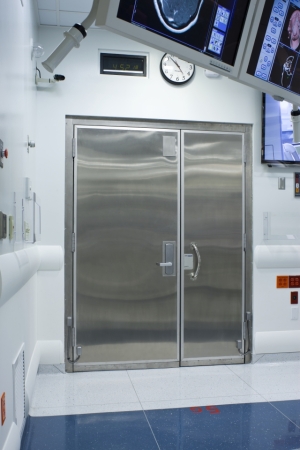por
Diana Bradley, Staff Writer | November 13, 2012

A shielded MRI door
(image courtesy of ETS-Lindgren).
From the October 2012 issue of HealthCare Business News magazine
The primary purpose of medical shielding is to do just that -- shield and protect hospital patients, visitors and staff from hazardous equipment and devices that produce X-rays and gamma rays. But one of the most popular high-density shielding materials is ironically a toxin itself: Lead.
Ranked number two on the Agency for Toxic Substances and Disease Registry’s 2011 Substance Priority List, lead poses a bigger risk to human health than mercury, methane and asbestos, along with a slew of lesser-known chemicals. Because of health concerns, lead from gasoline, paints and ceramic products, caulking, and pipe solder has been dramatically reduced in recent years, according to the ATSDR website. Even so, it is still widely used in medical shielding.
“Lead shielding has been in use throughout my 36-year tenure in Nuclear medicine,” says
Don Bogutski, president of Diagnostix Plus Inc., a supplier of new and refurbished nuclear medicine equipment and services.



Ad Statistics
Times Displayed: 85018
Times Visited: 5424 MIT labs, experts in Multi-Vendor component level repair of: MRI Coils, RF amplifiers, Gradient Amplifiers Contrast Media Injectors. System repairs, sub-assembly repairs, component level repairs, refurbish/calibrate. info@mitlabsusa.com/+1 (305) 470-8013
While concrete is commonly used for radiation containment, if space is limited, or a retrofit is needed, lead is the go-to material, according to
Chris Lewis, NELCO’s manager of design and engineering. For example, when applying shielding to a treatment room door, the door can be much smaller in size if lead is utilized.
“Essentially, one inch of lead is equivalent to six inches of concrete, so you can literally reduce the amount of material required to achieve the same thing,” Lewis explains.
NELCO provides shielding for the proton marketplace, radiation oncology, diagnostics for imaging and MRI shielding. The company continues to use lead in combination with other materials for radiation shielding.
But lead isn’t used in all medical shielding. For example, it is not an ideal material for RF shielding vendors, notes
Benjamin Turner, VP of Global Business Development for ETS-Lindgren (ETS-L), an RF shielding manufacturer. But even there, exceptions exist.
“With the advent of multi-modality equipment (PET/MR, PET/CT) you may have a situation where you need to combine radiation shielding materials with RF shielding materials, but for the most part, this is done by two separate vendors,” he says.
On the other hand, for those vendors that regularly use lead, the substance has recently become a target for limited and safer use.
“Many companies around the world are trying to eliminate lead from their product,” says Joe Sery, CEO, Tungsten Heavy Powder, Inc., a tungsten powder manufacturer. “They just feel lead is too toxic.”

